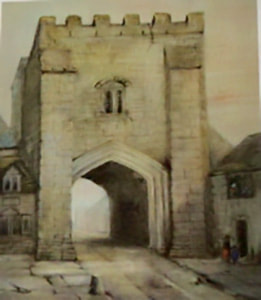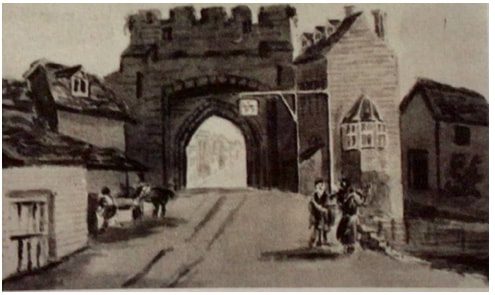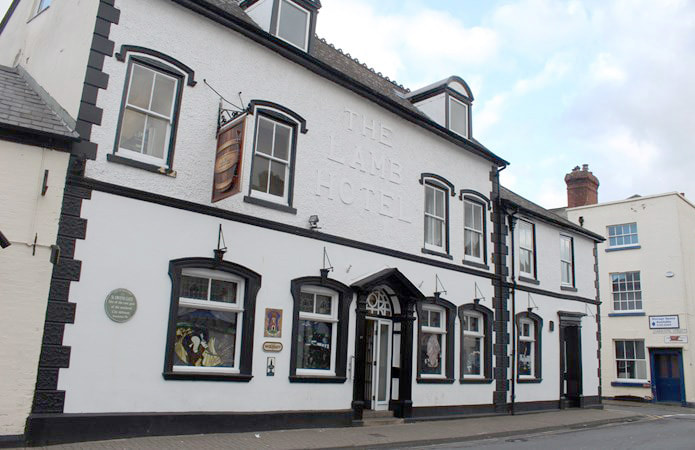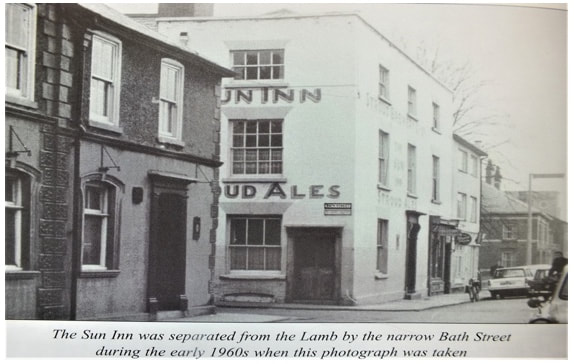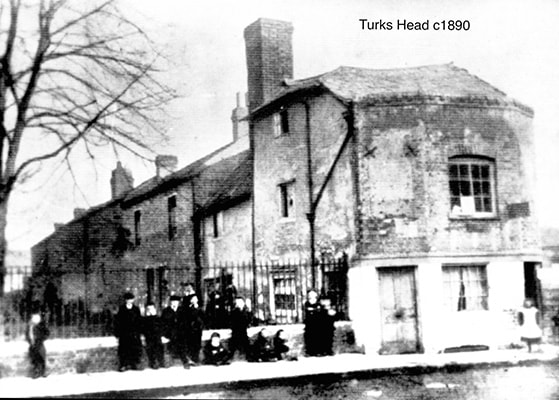Public Houses around St Owen Gate
The earliest hostelries can be traced back to Roman time, where a town would boast at least one tavern in order for a weary traveller to purchase food, drink and possibly lodgings for the night after a long journey. Because of this most hostelries and lodging houses tended to exist around the city gates and the road leading into the town. St Owen Gate is no exception and since medieval times there are records of at least sixteen drinking establishments in this area that served the good people of St Owen Parish.
Is it a coincidence that several pubs in this location had names that were associated with the Knights Templars such as the Lamb, Lamb and Flag and the Turks Head and in 1927 during the widening of the junction of St Owen Street and Ledbury Road and relocation of St Giles Chapel that the foundations of a Knights Templar church was discovered?
Is it a coincidence that several pubs in this location had names that were associated with the Knights Templars such as the Lamb, Lamb and Flag and the Turks Head and in 1927 during the widening of the junction of St Owen Street and Ledbury Road and relocation of St Giles Chapel that the foundations of a Knights Templar church was discovered?
The Lamb and Flag tavern
The Lamb and Flag dates back to at least 1700 and was inside St Owen Gate opposite Gaol Street (formerly Grope Lane). The inn had been built against the inside face of the city wall and apparently quite large as it covered the footprint of the three buildings that are on that site today, probably demolished around the same time as the gate was demolished.
The Lamb and Flag dates back to at least 1700 and was inside St Owen Gate opposite Gaol Street (formerly Grope Lane). The inn had been built against the inside face of the city wall and apparently quite large as it covered the footprint of the three buildings that are on that site today, probably demolished around the same time as the gate was demolished.
|
Viewed from inside St Owen Gate the building on the right could be the Lamb and Flag as it is in the exact location opposite Gaol Street. The building on the left hand side is still there today as part of outside wall of the Taste of Raj restaurant. When walking past you can see the brickwork above where the window arch was. The Pubs of Hereford City: Ron Shoesmith Logaston Press, Almley, 1998. The Story of Hereford: Andy Johnson and Ron Shoesmith Logaston Press, Almley 2016 |
The Lamb
|
The Barrels, formerly known as the Lamb Hotel, has a long history, built just outside the gate alongside the old city ditch. In the 18th century the inn was owned by the city authorities, and during the seventeen hundreds it was recorded that the then tenant paid an annual rent of 6s.8d but when the lease was renewed in the 19th century it varied from £13 upwards for a 21 year term. In 1816, Hereford Corporation, the owner, sold it by auction to James Ridler who died leaving it to his wife Mary. When Mary died, intestate in 1833, the property passed to her brother Richard who left his London business to run the Lamb. His son, another Richard, built a successful cider business – being the first to supply the US White House with cider after prohibition ended
|
In the1820s it is listed on licencing documents as the Lamb and Flag and reverted to its old name somewhat later. The Lamb Inn was improved in 1880s and when sold in 1906 it was listed as having 5 best bedrooms, stables for 5 horses and a number of outhouses and storerooms including a manure pit. It was owned by a number of breweries in the 20th century before being acquired in 1986 by Peter Amor, founder of Wye Valley Brewery. Peter renamed it the Barrels and started brewing in the old coach house until 2002 when the operation moved to Stoke Lacy. |
The Sun Inn
|
Located on the corner of St Owen Street & Harrison Street (formerly Bath Street, until construction of the inner ring road in the 1960s), the Sun Inn dates back to at least 1777 when a lease describes it as “formerly known as The Dog and Bear, now The Sun”. A small shop was inserted into the St Owen Street aspect in the mid-19th Century
1861 Census it was run by Louisa Mann widow described as Victualler and Henry Barrington brewer. Ten years later in 1871 it was run by Thomas Tandy Innkeeper and his wife Caroline. The present building dates from late 18th century, with some 19th century modifications, although the cellars may be from an earlier building. Grade II Listed by English Heritage (now Historic England) in 1992, the interior still has many early 19th century features. |
For a while, it was known as the Rising Sun and one landlord tried, unsuccessfully, to retitle it as The Angel. However, The Sun it remained for many years and it held out to become one of the few surviving, remodelled pubs in the city, well into the 1990s. A visit to The Sun was like stepping back in time. Frequented mainly, by just a few locals who usually took advantage of the huge barrel of Bulmer's Traditional located on the bar counter.
In later years, with a change of tenant, a half-hearted attempt at modernisation was made & the building rejoiced in the name “Bushwhackers”. Largely due to planning issues, this reinvention was unsuccessful & the doors closed for the last time in 1998.
The building was then converted to a health & fitness club & later redeveloped for housing.
Little considered during its lifetime, had The Sun survived as a cider house, it would now be considered an interesting throwback to an era before piped muzak, games machines & generic beer.
The Buildings of England; Alan Brookes and Nikolaus Pevsner, Yale University Press, London, 2012. The Pubs of Hereford City: Ron Shoesmith and John Eisel, Logaston Press, Almley, 2004 ,National census 1861 and 1871
In later years, with a change of tenant, a half-hearted attempt at modernisation was made & the building rejoiced in the name “Bushwhackers”. Largely due to planning issues, this reinvention was unsuccessful & the doors closed for the last time in 1998.
The building was then converted to a health & fitness club & later redeveloped for housing.
Little considered during its lifetime, had The Sun survived as a cider house, it would now be considered an interesting throwback to an era before piped muzak, games machines & generic beer.
The Buildings of England; Alan Brookes and Nikolaus Pevsner, Yale University Press, London, 2012. The Pubs of Hereford City: Ron Shoesmith and John Eisel, Logaston Press, Almley, 2004 ,National census 1861 and 1871
The Ship Inn
The Ship Inn stood on the corner of St Owen street and Mill street. The city wall, leaving St Owen gate in a southerly direction, turns abruptly at right angles, and forms the boundary between the properties facing St Owen Street and those in Cantilupe Street. This change in direction was at the point where the 13th Century defences met up with the Saxon defences built 300 years earlier. From this point the old defensive line was reused following a gradual curve to the north east corner of Castle green, the Bailey of Hereford Castle. The Ship Inn lay on this bend and would thus have had the city ditch running through its yard and the city wall at its rear boundary.
The Ship was built directly opposite the site of the historic St Owen Church, one of the two churches that were so damaged during the siege in 1645 that they had to be demolished afterwards. If there had been an inn on this site before the Civil War, it is almost certain that it could have been damaged alongside the church.
There was certainly and inn on this site during the 19th century, The Ship Inn is recorded in the 1871 census stating that as well as a public house it also had its own brewhouse on site.
In 1890 The Hereford Imperial Brewery, owned by the Watkins family (of Alfred Watkins fame) took over and held the lease for fourteen years. The Ship Inn finally closed its doors in 1913, St Owens Court now occupies the site
The Pubs of Hereford City: Ron Shoesmith Logaston Press, Almley, 1998
The Turks Head Tavern
|
Following the ring road from Bath street into St Owen Street on the left hand side of the road is the old St Owen Church in the corner of the old church yard and what is now Daws Road is the site of the Turks Head Tavern. This was first mentioned in 1779 when it was sold at the Nags Head in Broad Street. In the late 1800s it was known as a lodging house, looking at the ordinance survey map of 1888 the building on this site is neither shown as an inn nor a public house so maybe it reverted to a lodging house. In 1900 it was demolished as part of slum clearance in the area. Click here to view article from the Hereford Times |
The Pubs of Hereford City: Ron Shoesmith Logaston Press, Almley, 1998 The Story of Hereford : Andy Johnson and Ron Shoesmith Logaston Press, Almley 2016
The Bricklayers Arms
Opposite the fire station Bricklayers Arms original it was one of a small group of cottages which up until recently were converted into several small businesses including Bullars Printers now been redeveloped into flats (name of flats)
The Bricklayers Arms was first licenced in 1858 and over the years the cottage was developed and extended as it is seen today it has had several name changes over the years to the Jolly Roger and is known as the Victory with its own brew house The Spinning Dog Brewery
Finally here is a list of some other names of long-gone Inns and Taverns associated St Owen Street and around the Gate:
Catherine Wheel c1436, Wilton’Ynne 1517,
Three Stirrups 1737, Boar’s Head Tavern 1794, Hand and Shears 1796, Prince Of Wales c1800
Catherine Wheel c1436, Wilton’Ynne 1517,
Three Stirrups 1737, Boar’s Head Tavern 1794, Hand and Shears 1796, Prince Of Wales c1800
